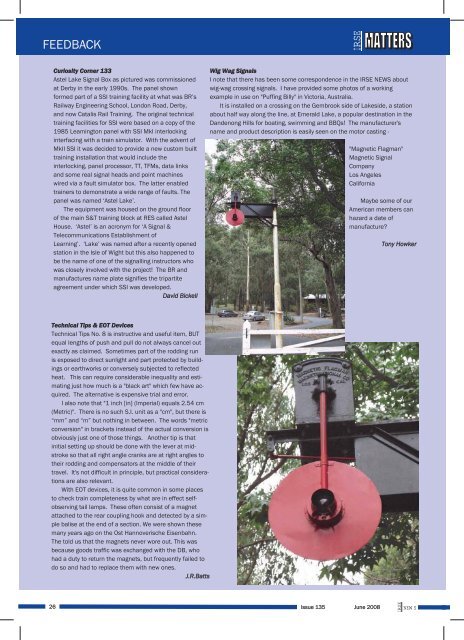IRSE News 135 Jun 08.pdf
IRSE News 135 Jun 08.pdf
IRSE News 135 Jun 08.pdf
Create successful ePaper yourself
Turn your PDF publications into a flip-book with our unique Google optimized e-Paper software.
FEEDBACK<br />
<strong>IRSE</strong><br />
Curiosity Corner 133<br />
Astel Lake Signal Box as pictured was commissioned<br />
at Derby in the early 1990s. The panel shown<br />
formed part of a SSI training facility at what was BR’s<br />
Railway Engineering School, London Road, Derby,<br />
and now Catalis Rail Training. The original technical<br />
training facilities for SSI were based on a copy of the<br />
1985 Leamington panel with SSI MkI interlocking<br />
interfacing with a train simulator. With the advent of<br />
MkII SSI it was decided to provide a new custom built<br />
training installation that would include the<br />
interlocking, panel processor, TT, TFMs, data links<br />
and some real signal heads and point machines<br />
wired via a fault simulator box. The latter enabled<br />
trainers to demonstrate a wide range of faults. The<br />
panel was named ‘Astel Lake’.<br />
The equipment was housed on the ground floor<br />
of the main S&T training block at RES called Astel<br />
House. ‘Astel’ is an acronym for ‘A Signal &<br />
Telecommunications Establishment of<br />
Learning’. ‘Lake’ was named after a recently opened<br />
station in the Isle of Wight but this also happened to<br />
be the name of one of the signalling instructors who<br />
was closely involved with the project! The BR and<br />
manufactures name plate signifies the tripartite<br />
agreement under which SSI was developed.<br />
David Bickell<br />
Wig Wag Signals<br />
I note that there has been some correspondence in the <strong>IRSE</strong> NEWS about<br />
wig-wag crossing signals. I have provided some photos of a working<br />
example in use on "Puffing Billy" in Victoria, Australia.<br />
It is installed on a crossing on the Gembrook side of Lakeside, a station<br />
about half way along the line, at Emerald Lake, a popular destination in the<br />
Dandenong Hills for boating, swimming and BBQs! The manufacturer's<br />
name and product description is easily seen on the motor casting -<br />
"Magnetic Flagman"<br />
Magnetic Signal<br />
Company<br />
Los Angeles<br />
California<br />
Maybe some of our<br />
American members can<br />
hazard a date of<br />
manufacture?<br />
Tony Howker<br />
Technical Tips & EOT Devices<br />
Technical Tips No. 8 is instructive and useful item, BUT<br />
equal lengths of push and pull do not always cancel out<br />
exactly as claimed. Sometimes part of the rodding run<br />
is exposed to direct sunlight and part protected by buildings<br />
or earthworks or conversely subjected to reflected<br />
heat. This can require considerable inequality and estimating<br />
just how much is a "black art" which few have acquired.<br />
The alternative is expensive trial and error.<br />
I also note that "1 inch [in] (Imperial) equals 2.54 cm<br />
(Metric)". There is no such S.I. unit as a "cm", but there is<br />
“mm” and “m” but nothing in between. The words "metric<br />
conversion" in brackets instead of the actual conversion is<br />
obviously just one of those things. Another tip is that<br />
initial setting up should be done with the lever at midstroke<br />
so that all right angle cranks are at right angles to<br />
their rodding and compensators at the middle of their<br />
travel. It's not difficult in principle, but practical considerations<br />
are also relevant.<br />
With EOT devices, it is quite common in some places<br />
to check train completeness by what are in effect selfobserving<br />
tail lamps. These often consist of a magnet<br />
attached to the rear coupling hook and detected by a simple<br />
balise at the end of a section. We were shown these<br />
many years ago on the Ost Hannoverische Eisenbahn.<br />
The told us that the magnets never wore out. This was<br />
because goods traffic was exchanged with the DB, who<br />
had a duty to return the magnets, but frequently failed to<br />
do so and had to replace them with new ones.<br />
J.R.Batts<br />
26<br />
Issue <strong>135</strong> <strong>Jun</strong>e 2008<br />
<strong>IRSE</strong><br />
NEWS

















